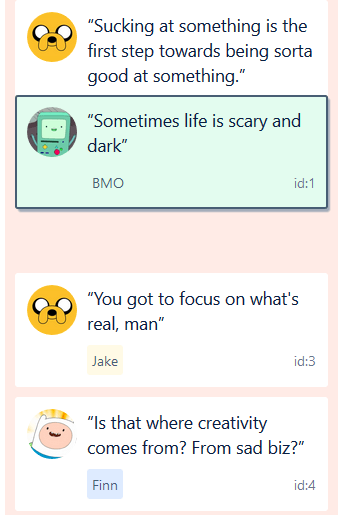今日推薦開源項目:《拖放 react-beautiful-dnd》
今日推薦英文原文:《A Day in the Life of an Engineering Leader》
順帶一提從今天開始到 2 月 1 日之前都放假哦,都去準備準備過個好年吧。

今日推薦開源項目:《拖放 react-beautiful-dnd》傳送門:GitHub鏈接
推薦理由:如果要想為頁面加入更好的與用戶互動的元素,增加可拖放的部分就是一個不錯的想法。這個項目是 React 的可拖放列表組件庫,drag and drop 簡稱為 dnd,不過和隔壁那個用途更廣的 react-dnd 不同,這個組件是專為列表形式的元素排列提供拖放的特化型組件,在列表上有著更好的表現。

今日推薦英文原文:《A Day in the Life of an Engineering Leader》作者:Isabel Nyo
原文鏈接:https://medium.com/better-programming/a-day-in-the-life-of-an-engineering-leader-532eba36b721
推薦理由:PM 的一天
A Day in the Life of an Engineering Leader
What it could look like when you move out of day-to-day programming
I am currently working as a software development manager at an enterprise software company in Sydney, Australia. My company develops products for agile teams consisting of software developers, product designers, product managers, and the likes.Similarly, my work involves working with agile teams. But because I am not an individual contributor nor a first-line manager, I am not directly part of an agile delivery team.
A large part of my day involves collaborating with various people from multiple disciplines, from engineering, product, recruiting, marketing, program management, support, etc., in one-to-one or one-to-many settings, what we call 「meetings」.
It』s less about day-to-day operations but more about business strategy, long-term goals, growth, culture, and the likes.
A Day in the Life of an Engineering Leader
Let me share with you a day in the life of an engineering leader.
Photo by Ekaterina Kasimova on Unsplash
8:30am-9:00am
I call this my quiet period to concentrate, set intention, and get on top of important things for the day.I have breakfast at my desk, look at my to-do list, decide what I』ll try to accomplish by the end of the day, and catch up on the status of various projects and people matters.
Sometimes, I have a good hour for this, but sometimes, I only have 15 minutes.
If I do have an early morning meeting or interview with someone from another part of the world, say at 8:00am, I try to get into the office early so that I can do my morning routine.
9:00am-10:00am
I joined a Product Brain Trust (PBT) for one of my teams with our leadership triad, which consists of head of engineering, head of design, and head of product.I usually listen in to try and understand their point-of-views. I am already aware of what my teams are working on but this is usually the first time for the leadership triad to hear and see about the ideas, concepts, and sometimes, low-fidelity designs.
I also take notes of important discussions to build on my knowledge about our product and customers and to share this knowledge back with my teams. An hour of PBT usually goes by quickly.
10:00am-10:30am
Most teams do daily standups between 10:00am and 10:30am as it』s the time when most people start their days, whether they work in the office or remotely.If I have a special project that I am managing with a temporary team like a tiger team, I』d join that standup. If I was looking after a delivery team because their engineer manager is away, I』d join their standup as necessary.
My principle here is that if I could add some value by being there, whether to provide insights, guidance, support, feedback, I』d be there.
Otherwise, I believe teams should be self-organizing and autonomous enough to facilitate their own standup.

Photo by CoWomen on Unsplash
10:30am-12:00pm
I usually have small focused meetings during this time. Some of them are 1:1s, others involve 3-4 people.My 1:1s are not just with my direct reports and my immediate manager. I also have 1:1s with people from various disciplines like support, marketing, product management, program management, talent acquisition, design, and so on.
Sometimes, these meetings turn into three people; for example, a customer interview including myself, someone from product or design, and a customer or a potential customer of our product.
12:00pm-1:00pm
I』ve blocked out time on my calendar for this period because it』s my balcony time. I usually have a quick 15-20 minute lunch and then use the rest of the time to get out of the building, go for a walk around the block, listen to a podcast, or just observe the world.I』m lucky that my office is in the Sydney CBD; which means I sometimes go for a walk around the Darling Harbor or the famous Sydney Opera House.
Sometimes, I just watch tourists enjoying the city and street performers doing their magic. It really helps me put things in perspective.

Photo by Susan Kuriakose on Unsplash
1:00pm-2:30pm
I』m back in the office and during this time, I usually have a leadership or values interview with a candidate. My company has been growing aggressively since I joined and thus, we have numerous roles open at any one time.As a leader, it』s one of my responsibilities to recruit great talent to the company. I do two to three interviews a week, sometimes more if there』s a need.
I try to be a good interviewer by really getting to know the interviewee, listening actively, asking clarifying questions because I believe that it』s a service you provide.
I am not going to lie, sometimes I find that the questions and answers get a bit old, but then there will be a candidate who would surprise me with something and make me feel that there』s always something new to learn from interviews.
2:30pm-3:30pm
After leadership or values interviews, I have another set of 1:1s. For example, a catch-up with an internal recruiter for an open role on one of my teams.I also have 1:1s with my direct reports who are engineering managers to give and receive feedback, get aligned on projects, discuss their growth, or with direct reports who are principal engineers to give and receive feedback, spar on technical architecture, and technical vision.
Lastly, I have 1:1s with my manager to discuss products, processes, and people and, yes, you guessed it, to give and receive feedback. They don』t all happen on the same day, during the same session though, in case you were wondering.

Photo by Joshua Ness on Unsplash
4:00pm-4:30pm
Some days, I』ll have quiet time to catch up on Slack messages, other days, I』ll join a Scrum of Scrums meeting, techOps meeting, or other department-wide meetings.I leave the office by 4:45pm as I need to pick up my daughter from school and commuting takes at least an hour.

Photo by Sebastien Gabriel on Unsplash
Being a Manager
Now, you might be asking, is being a manager all about meetings? Of course not, meetings alone aren』t enough in delivering outcomes. The above is an example of a few of my days during a week.I usually theme my day and organize my calendar carefully so I have at least one day during the week where I could have a block of time, i.e.: more than two hours, to fit in some strategy or execution work that』s not attending or facilitating meetings.
Sometimes, I can』t help but fit in two or three hours of work time after dinner with my family and homework with my daughter. But I try to not make it an everyday occurrence because I don』t want to be getting burnt out.
I also have other creative outlets and side-projects that I like to devote my time to. More often than not, they are indirectly related to my full-time job as a senior engineering leader.
For example, when I was asked to be on the panel for diversity and inclusion at work, I didn』t have to research much because I had already been doing research for my article previously.
Or when I offer mentoring and career coaching at work, I leverage my knowledge and experience obtained as a career coach outside my full-time work.

womenintechnology.threadless.com
What I』ve Learned
One of the biggest learnings throughout my career as a manager and leader is that you have to be flexible and you have to be able to adapt to changing requirements of the people and business.A lot of the things are often unknown. When you are a developer working on projects, you know what you』re going to be working on next week or even next month.
Your ability to deliver is on your capabilities, most of the time. When you』re a manager, things could change more frequently, you are no longer in control of most of the things around you.
You can』t mandate market, seasonality, or people』s desires. The role of a manager is also to shield their team from constant changes and noise from the outside so they can focus on delivering value for customers, whether they are new features or improvement or bug fixes to existing features.

Photo by Kelly Sikkema on Unsplash
Never a Dull Day
A day in my life as an engineering leader may look the same from the outside over a few months, but I can assure you that when you dig deep, each day could be completely different.For example, on day one, we might be discussing a new market we are going to go after in a few months but on day 15, we might be discussing an updated organization structure to support career growth for people.
Then, on day 30, we might be discussing performance reviews that we will be having in a few weeks and how to keep the process fair and consistent across the organization.
My days, weeks, and months vary and they are often not predictable. I have to say there is never a dull day as an engineering leader.
Unpredictable as it may be, and sometimes it feels like you』re not contributing anything worth mentioning because the feedback loop is so slow, I know from experience that the job of an engineering manager can be truly impactful through processes, products, and most importantly, people.

Photo by Dan Meyers on Unsplash
下載開源日報APP:https://openingsource.org/2579/
加入我們:https://openingsource.org/about/join/
關注我們:https://openingsource.org/about/love/

日曆搞錯啦,2020年了!
@Tom: 感謝提醒,多謝啦,新年快樂!